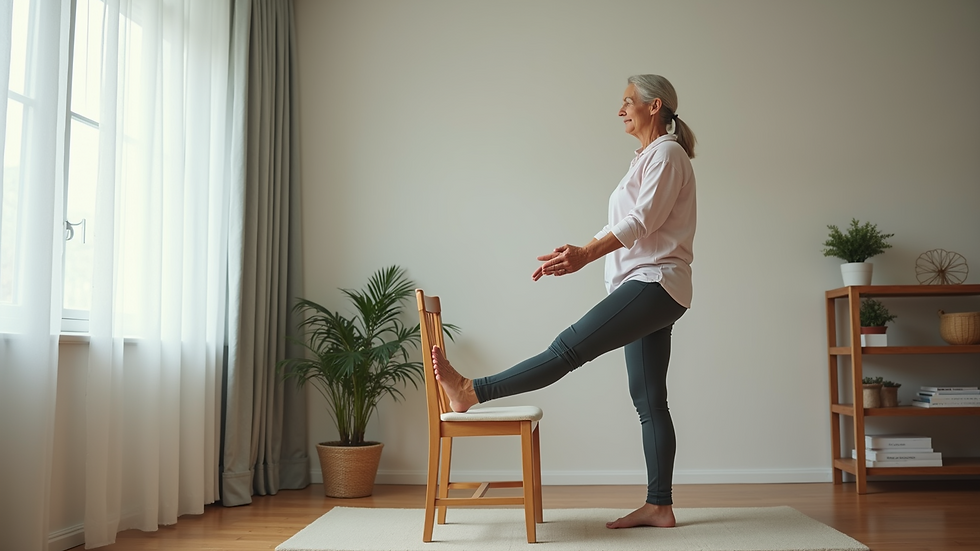Creating Effective Custom Fitness Plans for Seniors
- mtribble648
- Oct 13
- 3 min read
Designing fitness programs for seniors requires a clear understanding of their unique needs and limitations. Physical activity is essential for maintaining health and independence in later years. However, a one-size-fits-all approach does not work well for this demographic. Tailored senior fitness strategies ensure that exercise routines are safe, effective, and enjoyable.
Importance of Tailored Senior Fitness Strategies
Seniors experience changes in muscle mass, bone density, balance, and cardiovascular health. These changes affect their ability to perform certain exercises and increase the risk of injury. Tailored fitness strategies address these factors by focusing on:
Strength training to maintain muscle mass and bone health.
Balance exercises to reduce fall risk.
Flexibility routines to improve mobility.
Cardiovascular workouts to support heart health.
A personalized approach considers medical history, current fitness level, and personal goals. This ensures that seniors engage in activities that promote overall well-being without overexertion.

Assessing Individual Needs and Limitations
Before creating a fitness plan, it is crucial to conduct a thorough assessment. This includes:
Medical Evaluation: Review any chronic conditions such as arthritis, diabetes, or heart disease.
Physical Fitness Testing: Measure strength, flexibility, balance, and endurance.
Lifestyle Analysis: Understand daily activity levels, diet, and social habits.
Goal Setting: Identify what the individual wants to achieve, such as improved mobility or weight management.
This assessment guides the selection of appropriate exercises and intensity levels. It also helps identify any contraindications or precautions.
What is the Best Fitness Program for Seniors?
The best fitness program for seniors combines multiple components to address their comprehensive health needs. A balanced program typically includes:
Aerobic Exercise: Activities like walking, swimming, or cycling improve cardiovascular health. Aim for at least 150 minutes of moderate-intensity aerobic activity per week.
Strength Training: Use resistance bands, light weights, or bodyweight exercises twice a week to maintain muscle strength.
Flexibility and Stretching: Daily stretching routines help maintain joint range of motion.
Balance Training: Exercises such as tai chi or standing on one leg reduce fall risk.
Programs should start slowly and progress gradually. Monitoring response to exercise is essential to avoid injury and ensure continued motivation.

Incorporating Nutrition and Recovery
Fitness is not solely about exercise. Nutrition and recovery play vital roles in senior health. Proper nutrition supports muscle repair, energy levels, and immune function. Recommendations include:
Adequate Protein Intake: To support muscle maintenance.
Hydration: Seniors often have a reduced sense of thirst.
Balanced Diet: Rich in fruits, vegetables, whole grains, and healthy fats.
Recovery strategies such as sufficient sleep, rest days, and gentle stretching reduce the risk of overtraining and injury.
Implementing Custom Fitness Plans for Seniors
Creating custom fitness plans for seniors involves collaboration between fitness professionals and the individual. Key steps include:
Personalized Program Design: Tailor exercises to individual capabilities and preferences.
Regular Monitoring and Adjustment: Track progress and modify the plan as needed.
Education and Support: Provide guidance on proper technique and motivation.
Community Engagement: Encourage participation in group classes or social activities to enhance adherence.
This approach fosters a sustainable fitness routine that improves quality of life.

Encouraging Consistency and Long-Term Success
Consistency is critical for achieving fitness benefits. Strategies to promote adherence include:
Setting realistic, measurable goals.
Scheduling regular workout times.
Incorporating enjoyable activities.
Providing positive reinforcement.
Addressing barriers such as transportation or health concerns.
Long-term success depends on maintaining motivation and adapting the program to changing needs.
Supporting Health and Wellness in Northwest Georgia
D&M Wellness Solutions is committed to helping individuals in Northwest Georgia achieve healthier lives through expert guidance and personalized support. Their focus on tailored senior fitness strategies ensures that older adults receive safe and effective programs designed to enhance their independence and well-being.
By integrating exercise, nutrition, and community support, seniors can experience improved physical function and a higher quality of life.
This comprehensive approach to senior fitness emphasizes safety, personalization, and sustainability. Tailored programs that consider individual needs and preferences are essential for promoting health and vitality in later years.





Comments